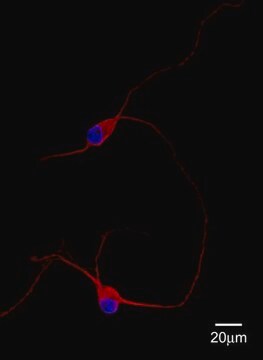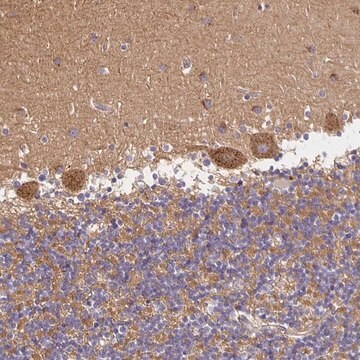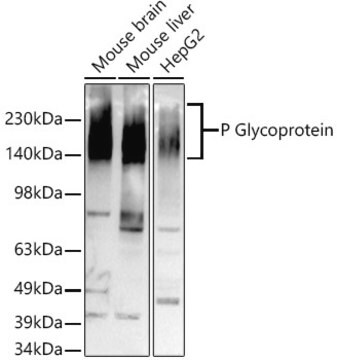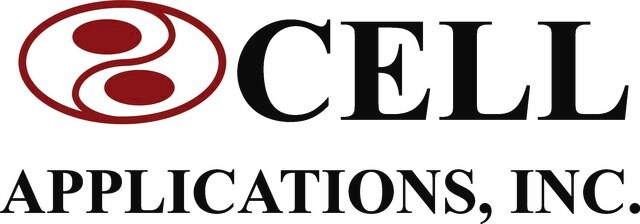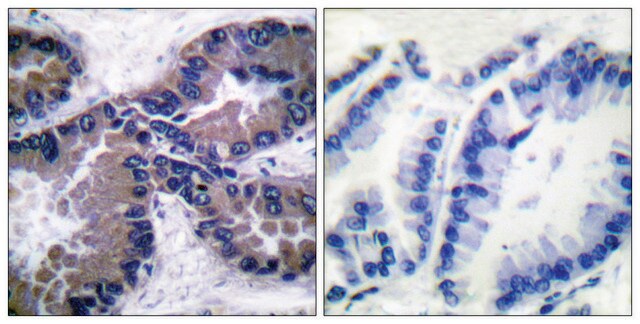MABN1793
Anti-SorLA Antibody, clone 20C11
clone 20C11, from mouse
동의어(들):
Sortilin-related receptor, Gp250, LDLR relative with 11 ligand-binding repeats, Low-density lipoprotein receptor relative with 11 ligand-binding repeats, LR11, SorLA, SorLA-1, Sorting protein-related receptor containing LDLR class A repeats
로그인조직 및 계약 가격 보기
모든 사진(2)
About This Item
UNSPSC 코드:
12352203
eCl@ss:
32160702
NACRES:
NA.41
추천 제품
생물학적 소스
mouse
Quality Level
항체 형태
purified immunoglobulin
항체 생산 유형
primary antibodies
클론
20C11, monoclonal
종 반응성
mouse, human
기술
ELISA: suitable
immunocytochemistry: suitable
western blot: suitable
동형
IgG1κ
NCBI 수납 번호
UniProt 수납 번호
타겟 번역 후 변형
unmodified
유전자 정보
human ... SORL1(6653)
일반 설명
Sortilin-related receptor (UniProt Q92673; also known as Gp250, LDLR relative with 11 ligand-binding repeats, Low-density lipoprotein receptor relative with 11 ligand-binding repeats, LR11, SorLA, SorLA-1, Sorting protein-related receptor containing LDLR class A repeats) is encoded by the SORL1 (also known as C11orf32) gene (Gene ID 6653) in human. SorLA and Sortilin are related Vps10p-domain (Vsp10p-D) family multi-ligand-binding receptors that target LPL, growth factors and peptides, as well as soluble amyloid precursor proein (sAPP) for endocytosis. Studies show that SorLA protects sAPP against proteolytic processing in compartments localized in the cell body (soma) of hippocampal neurons, whereas sortilin facilitates sAPP degradation by lysosomes localized in neurites. Hippocampal neurons lacking sortilin display reduced sAPPα production, suggesting that sortilin promotes α-secretase activity in neuronal systems. Unlike LRP1 and LRP1b, two other known sAPP-binding receptors, SorLA and Sortilin bind sAPP in a KPI domain-independent manner and their scavenging function therefore is not limited to sAPP produced from KPI-containing APP isoforms. Human SorLA is a single transmembrane (a.a. 2138-2158) protein with a 55-amino acid cytoplasmic tail (a.a. 2159-2214) and a large luminal/extracellular (a.a. 1-2137) region that contains a Vps10p-domain (Vsp10p-D; a.a. 1-731) with a signal peptide (a.a. 1-28) and a propeptide (a.a. 29-81) sequence at the N-terminal end and five BNR (bacterial neuraminidase repeat or (F/Y)WTD/b-propeller domain) repeats (a.a. 136-573). The C-terminal half of the luminal/extracellular region contains five LDL-R class B (LB) repeats (a.a. 800-1013), an EGF-like domain (a.a. 1026-1072), eleven LDL-R class A (LA) repeats (a.a. 1076-1551), and six fibronectin type-III repeats (a.a. 1557-2118).
특이성
Clone 20C11 immunostained SorLA endocytic vesicles in wild-type, but not Sorl1-/-, mouse astrocytes.
면역원
Epitope: Extracellular/luminal region outside the Vps10p domain (Vsp10p-D).
Recombinant human SorLA extracellular/luminal domain.
애플리케이션
Anti-SorLA Antibody, clone 20C11 is an antibody against SorLA for use in Immunocytochemistry, Western Blotting, ELISA.
Immunocytochemistry Analysis: 5 µg/mL from a representative lot immunostained SorLA endocytic vesicles in wild-type, but not Sorl1-/-, mouse astrocytes (Courtesy of Dr. Jakob V. Larsen, MIND-centre, University of Aarhus, Denmark).
Immunocytochemistry Analysis: A representative lot detected SorLA immunoreactivity primarily located at the cell body (soma) by fluorescent immunocytochemistry staining of 4% paraformaldehyde-fixed, 0.1% Triton X-100-permeabilized primary murine hippocampal neurons (Gustafsen, C., et al. (2013). J. Neurosci. 33(1):64-71).
Immunocytochemistry Analysis: A representative lot immunostained endocytic vesicular structures containing endocytosed sAPP by fluorescent immunocytochemistry staining of 4% paraformaldehyde-fixed, 0.1% Triton X-100-permeabilized HEK293 cells expressing exogenously transfected human SorLA (Gustafsen, C., et al. (2013). J. Neurosci. 33(1):64-71).
Immunocytochemistry Analysis: A representative lot detected the cellular localization of exogenously expressed wild-type and the FANSHY-to-6A4 mutant human SorLA by fluorescent immuncytochemistry staining of 4% paraformaldehyde-fixed, 0.5% saponin-permeabilized SH-SY5Y transfectants (Fjorback, A.W., et al. (2012). J. Neurosci. 32(4):1467-1480).
Western Blotting Analysis: A representative lot detected endogenous SorLA in sucrose gradient-fractionated mouse brain extracts as well as the expression of exogenously transfected human SorLA in HEK293 transfectants (Gustafsen, C., et al. (2013). J. Neurosci. 33(1):64-71).
ELISA Analysis: Representative lots were employed as the detection antibody for quantiating SorLA level in human brain cortical extracts as well as the level of exogenously expressed human SorLA in CHO cells (Caglayan, S., et al. (2012). Arch. Neurol. 69(3):373-379; Schmidt, V., et al. (2012). EMBO J. 31(1):187-200).
Immunocytochemistry Analysis: A representative lot detected SorLA immunoreactivity primarily located at the cell body (soma) by fluorescent immunocytochemistry staining of 4% paraformaldehyde-fixed, 0.1% Triton X-100-permeabilized primary murine hippocampal neurons (Gustafsen, C., et al. (2013). J. Neurosci. 33(1):64-71).
Immunocytochemistry Analysis: A representative lot immunostained endocytic vesicular structures containing endocytosed sAPP by fluorescent immunocytochemistry staining of 4% paraformaldehyde-fixed, 0.1% Triton X-100-permeabilized HEK293 cells expressing exogenously transfected human SorLA (Gustafsen, C., et al. (2013). J. Neurosci. 33(1):64-71).
Immunocytochemistry Analysis: A representative lot detected the cellular localization of exogenously expressed wild-type and the FANSHY-to-6A4 mutant human SorLA by fluorescent immuncytochemistry staining of 4% paraformaldehyde-fixed, 0.5% saponin-permeabilized SH-SY5Y transfectants (Fjorback, A.W., et al. (2012). J. Neurosci. 32(4):1467-1480).
Western Blotting Analysis: A representative lot detected endogenous SorLA in sucrose gradient-fractionated mouse brain extracts as well as the expression of exogenously transfected human SorLA in HEK293 transfectants (Gustafsen, C., et al. (2013). J. Neurosci. 33(1):64-71).
ELISA Analysis: Representative lots were employed as the detection antibody for quantiating SorLA level in human brain cortical extracts as well as the level of exogenously expressed human SorLA in CHO cells (Caglayan, S., et al. (2012). Arch. Neurol. 69(3):373-379; Schmidt, V., et al. (2012). EMBO J. 31(1):187-200).
품질
Evaluated by Immunocytochemistry in human SorLA-expressing HEK293 cells.
Immunocytochemistry Analysis: 4.0 µg/mL of this antibody immunostained SorLA endocytic vesicles in HEK293 cells expressing transfected human SorLA.
Immunocytochemistry Analysis: 4.0 µg/mL of this antibody immunostained SorLA endocytic vesicles in HEK293 cells expressing transfected human SorLA.
표적 설명
239.3 kDa (human) and 238.3 kDa (mouse) calculated.
물리적 형태
Format: Purified
기타 정보
Concentration: Please refer to lot specific datasheet.
적합한 제품을 찾을 수 없으신가요?
당사의 제품 선택기 도구.을(를) 시도해 보세요.
Storage Class Code
12 - Non Combustible Liquids
WGK
WGK 1
Flash Point (°F)
Not applicable
Flash Point (°C)
Not applicable
시험 성적서(COA)
제품의 로트/배치 번호를 입력하여 시험 성적서(COA)을 검색하십시오. 로트 및 배치 번호는 제품 라벨에 있는 ‘로트’ 또는 ‘배치’라는 용어 뒤에서 찾을 수 있습니다.
Guillermo A Herrera et al.
Kidney international reports, 6(5), 1379-1396 (2021-05-21)
Deciphering the intricacies of the interactions of glomerulopathic Ig light chains with mesangial cells is key to delineate signaling events responsible for the mesangial pathologic alterations that ensue. Human mesangial cells, caveolin 1 (CAV1), wild type (WT) ,and knockout (KO)
자사의 과학자팀은 생명 과학, 재료 과학, 화학 합성, 크로마토그래피, 분석 및 기타 많은 영역을 포함한 모든 과학 분야에 경험이 있습니다..
고객지원팀으로 연락바랍니다.